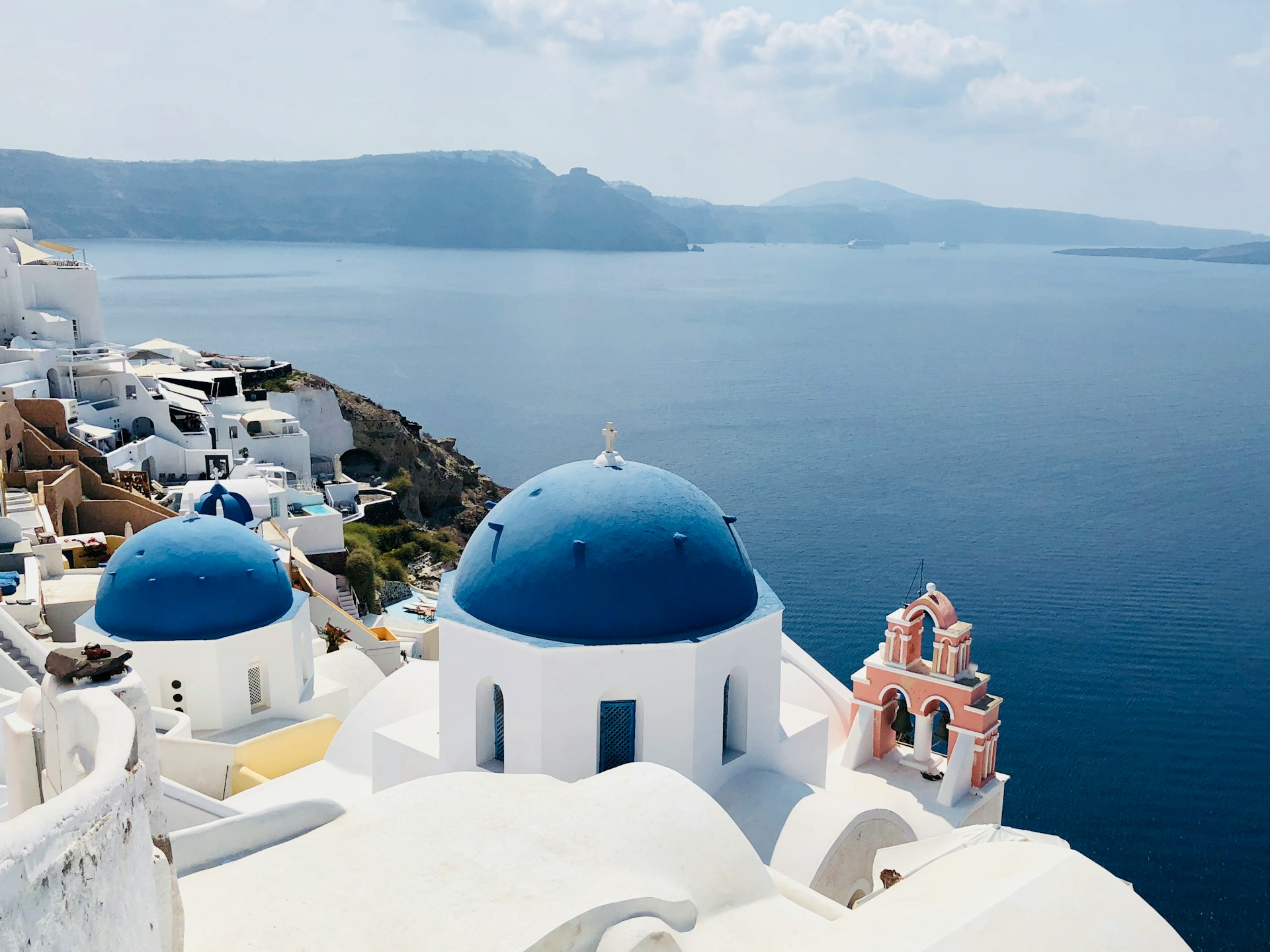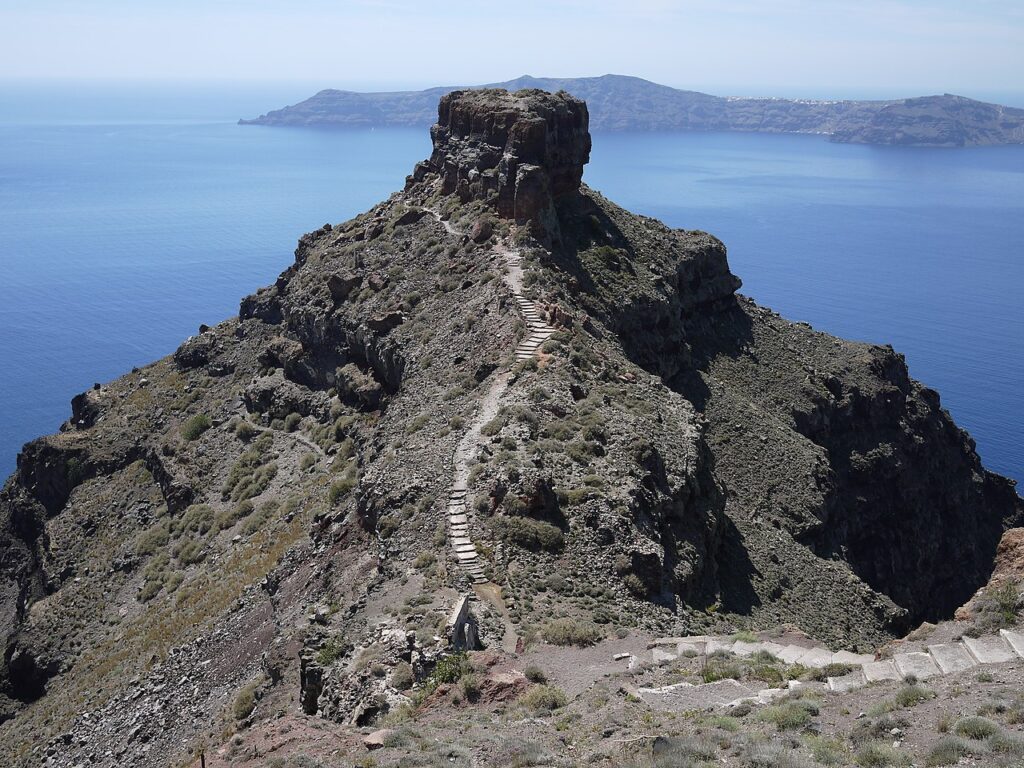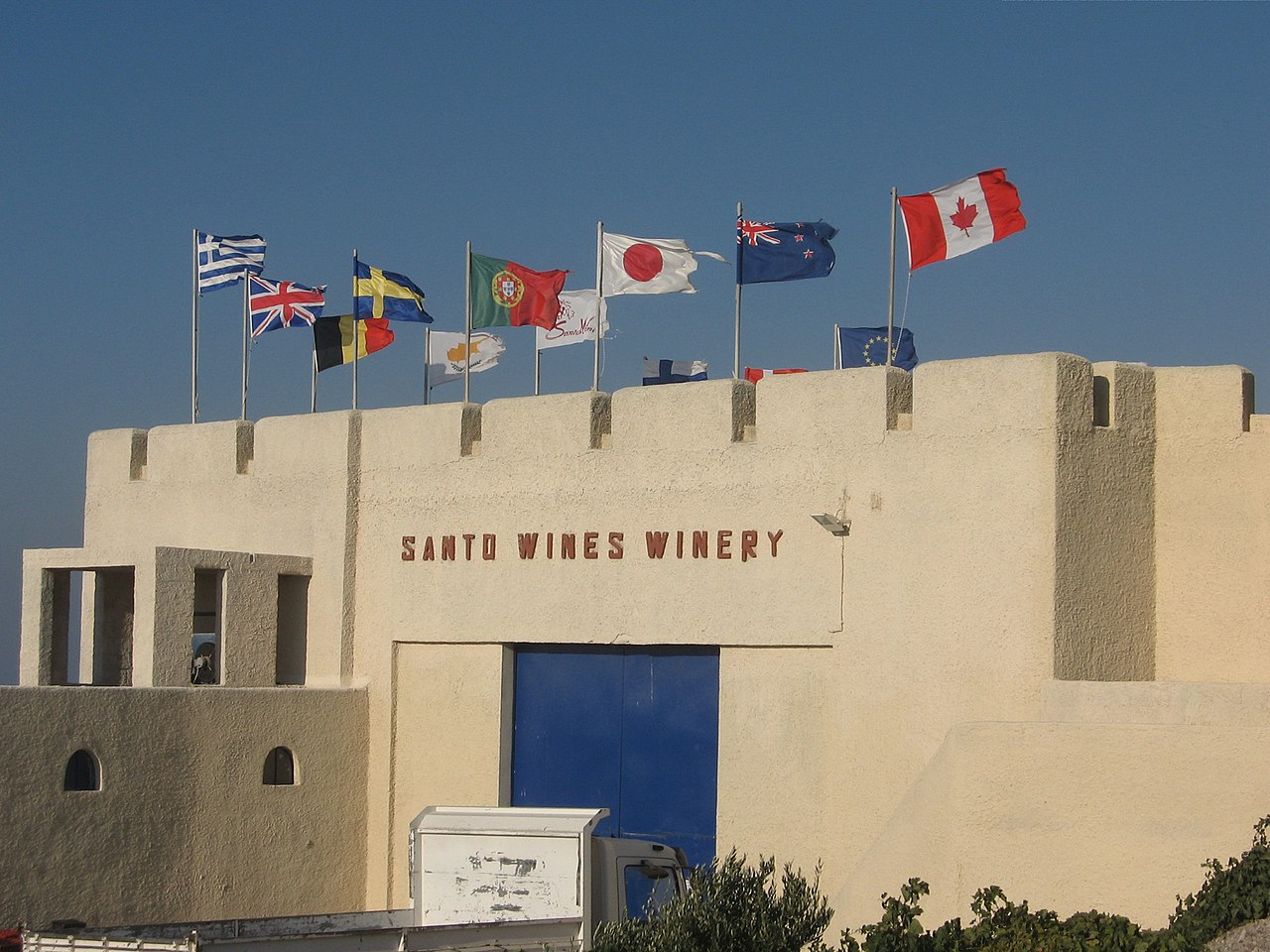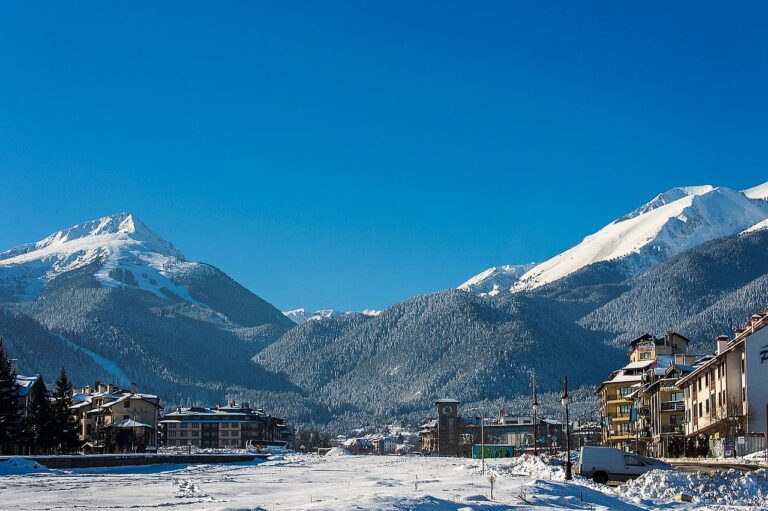Welcome to Santorini, the jewel of the Aegean Sea, celebrated for its breathtaking sunsets, iconic blue-domed white buildings, and unparalleled views of the caldera. This Greek island isn’t just one of the most photogenic places on Earth; it is also steeped in history, rich in culture, and brimming with unforgettable culinary delights. From mystical ruins enshrouded in volcanic ash to lively festivals resonating with traditional music, Santorini seamlessly blends its historic past with a vibrant present. In this guide, we provide everything you need to maximize your visit: from travel tips and must-try local dishes to hidden spots that only the most intrepid travelers discover. Join us as we explore all the wonders of Santorini, an island that promises a once-in-a-lifetime adventure.

Geographical Location
Santorini, a stunning gem nestled in the heart of the Aegean Sea, is one of the most renowned islands of the Cyclades group. This island is uniquely shaped like a crescent, a form that emerged from the catastrophic volcanic eruption around 1600 BCE. This event dramatically altered the island’s topography, leading to the creation of its famous caldera—a large, cauldron-like hollow that offers breathtaking views.
The crescent shape of Santorini provides a unique natural amphitheater from which visitors can enjoy panoramic views of the deep blue waters of the Aegean against a backdrop of steep cliffs. This geographical feature has not only influenced the island’s dramatic and stunning landscapes but also its development and architecture. Buildings perched along the caldera edge are a testament to human ingenuity in harmonizing with such a dramatic natural setting. The island’s layout offers an unparalleled opportunity for visitors to witness stunning sunsets that light up the sky and sea, turning them into a canvas of vibrant colors.
Santorini’s geographical position also makes it a pivotal point in the Aegean for both ancient and modern navigators. Situated between the Greek mainland and the sprawling expanse of the Eastern Mediterranean, the island has long been a crucial maritime hub. Today, this location continues to enhance its appeal as a tourist destination, accessible yet wonderfully isolated in the vast blue of the Aegean.
History and Culture
Santorini’s history is as dramatic as its landscapes. The island’s past is deeply intertwined with the Minoan civilization, which flourished on Crete and extended its influence to Santorini during the Bronze Age. The zenith of this era is vividly preserved at Akrotiri, a Minoan outpost on the island, which was remarkably well-preserved under layers of volcanic ash. The site offers a fascinating glimpse into the advanced urban planning, sophisticated multi-story buildings, and vibrant frescoes that depict a prosperous society engaged in various aspects of life and commerce.
The defining moment in Santorini’s historical narrative came around 1600 BCE, when the island experienced one of the largest volcanic eruptions in human history. This catastrophic event not only reshaped the island’s geography but also had profound effects on its culture and architecture. The eruption led to the collapse of the Minoan civilization on the island and created the stunning caldera that Santorini is known for today.

The aftermath of the eruption influenced local architecture, compelling the inhabitants to adapt to a radically altered landscape. Traditional Cycladic architecture, characterized by cubic shapes and flat roofs, was not only aesthetically pleasing but also practical, designed to withstand the harsh winds and protect from the sun’s glare. The iconic white-painted buildings with blue domes, now symbolic of Santorini, reflect a blend of practicality and beauty, maximizing light and providing heat relief.
Culturally, the impact of the eruption permeated through generations, embedding a deep respect for the forces of nature in the local ethos. This respect is reflected in the island’s numerous religious festivals and rituals, many of which involve supplications to protect the island from further natural calamities.
Today, Santorini’s culture is a vibrant tapestry of its ancient roots and modern influences, a hub for artists, musicians, and chefs who draw inspiration from its storied past and spectacular natural surroundings. The island’s culture is celebrated annually in various festivals that showcase traditional music, dance, and culinary practices, inviting visitors to partake in these living traditions that continue to shape Santorini’s unique cultural landscape.
Climate and Weather:
Santorini enjoys a Mediterranean climate, which means it offers long, warm summers and mild, wet winters. This type of climate is ideal for those looking to soak in the sun and enjoy outdoor activities, making Santorini a popular destination from late spring to early fall.
Summer (June to September): Summers in Santorini are typically hot and dry, with average temperatures ranging from 25°C to 30°C (77°F to 86°F). The warmest months, July and August, can see temperatures climbing above 30°C, particularly during heatwaves. Despite the heat, summer is the peak tourist season, thanks to the nearly guaranteed perfect beach weather and vibrant nightlife. However, visitors should be prepared for large crowds and higher prices during this period.
Fall (October to November): The autumn months see a drop in temperatures, averaging between 15°C and 25°C (59°F to 77°F). The sea remains warm enough for swimming, and the island begins to quiet down, making this a great time to visit if you prefer a more relaxed atmosphere with fewer tourists.
Winter (December to February): Winters are mild but can be quite rainy, with temperatures usually ranging from 10°C to 15°C (50°F to 59°F). While it’s the off-season for tourism, winter visitors can enjoy the local culture without the crowds. Many hotels and restaurants may be closed, however, so it’s important to plan accordingly.
Spring (March to May): Spring brings with it a rejuvenation of the island’s beauty. Temperatures gradually rise from about 13°C to 20°C (55°F to 68°F), and the landscape is lush and colorful, making it an ideal time for photographers and nature lovers. This season also sees fewer tourists than summer, offering a more tranquil experience.
The best time to visit Santorini largely depends on your weather preferences and what you want to do on the island. For beach activities and vibrant nightlife, summer is perfect, though it’s also the most crowded and expensive time. Spring and fall offer pleasant weather with fewer crowds and are ideal for sightseeing, hiking, and exploring the island’s cultural offerings. Winter, while quieter, allows for an intimate experience of the local way of life, though travel plans should accommodate the seasonal closure of some amenities.

How to Reach Santorini:
Santorini is well-connected and accessible, offering various options for travelers to reach its stunning shores:
By Air: Santorini National Airport serves both international flights and numerous daily flights from Athens. The flight from Athens to Santorini typically lasts about 45 minutes. Many European cities also offer direct seasonal flights, making it convenient for international tourists during the peak summer months. Booking in advance is highly recommended, especially for travel during high season, to secure the best rates and availability.
By Sea: Ferry and high-speed boat services operate between Santorini and other major Greek islands, as well as from Piraeus, the main port of Athens. The journey from Piraeus can take anywhere from 5 to 8 hours depending on the service (ferry or high-speed boat). This is a popular choice for those who prefer a scenic approach to the island, with the added advantage of carrying more luggage. Booking tickets in advance is advisable as services can fill up quickly, especially in the summer.
Upon Arrival: Once on the island, transportation options include buses, taxis, and car rentals. The main bus terminal in Fira connects various parts of the island, making it convenient to reach major attractions. Renting a car or a scooter offers more flexibility but be aware of narrow and busy roads during peak season. Taxis are available but can be scarce in high demand periods, so planning ahead is key.
For a smooth travel experience, always check the latest schedules and book your transport in advance, particularly during the peak tourist season. Additionally, familiarizing yourself with the layout of Santorini’s main town and your accommodation’s location can help you navigate more efficiently upon arrival.
What to See and Do in Santorini
Main Tourist Attractions:
Santorini is not just a stunning destination with breathtaking views, but also a place rich with historical sites, charming villages, and unique natural formations. Here’s a guide to the island’s must-visit attractions:
Archaeological Site of Akrotiri:

Discover this well-preserved prehistoric town, often referred to as the “Minoan Pompeii.” Buried under volcanic ash during the massive eruption in the 17th century BCE, Akrotiri offers a fascinating glimpse into the advanced civilization that once thrived on Santorini. Walkways allow you to explore multi-story buildings and admire frescoes and artifacts that reveal aspects of ancient life.
Oia:

This picturesque village is famed for its iconic blue-domed churches and spectacular sunsets. Wander through its narrow, winding streets lined with boutique shops, cafes, and galleries. Don’t miss the chance to capture the sunset from the castle ruins, a favorite spot among photographers.
Fira:

The bustling capital of Santorini, perched on the edge of a 400-meter high caldera. Explore its white cobblestone streets, visit the Archaeological Museum of Thera, and enjoy the stunning views over the volcanic waters below.
Pyrgos:

Experience the traditional life of the Cyclades in this quaint village. Climb to the Venetian castle for panoramic views and explore the historical churches scattered throughout the village.
Imerovigli:

Known as the ‘Balcony to the Aegean,’ this village offers breathtaking views from the highest point of the caldera cliffs. It’s an ideal spot for a peaceful stroll and watching the sunset in a quieter setting.
Beaches of Santorini:

From the distinctive red sands of Red Beach to the organized black pebble beaches of Kamari and Perissa, each beach offers a unique atmosphere. Explore the secluded coves or enjoy the lively beach bars and water sports.
Ancient Thera:

The ruins on a high rocky headland include remains from Hellenistic, Roman, and Byzantine periods. The site provides a historical backdrop along with dramatic views over the southeastern beaches of the island.
Amoudi Bay:


Just below Oia, this charming port features excellent seafood restaurants and offers activities like swimming and cliff diving. It’s a perfect spot to enjoy the sea and watch the sunset.
Skaros Rock:

Located in Imerovigli, this former site of a medieval castle offers a challenging hike rewarded with stunning views of the caldera.
Santo Wines Winery:

A visit to this winery offers insight into the island’s winemaking tradition, tastings of local varieties like Assyrtiko, and incredible caldera views, especially at sunset.
Museum of Prehistoric Thera:

Situated in Fira, this museum displays artifacts from Akrotiri, including frescoes and ceramics that provide further insight into the prehistoric inhabitants of Santorini.
Each of these destinations offers a glimpse into the diverse appeal of Santorini, from its archaeological treasures and stunning natural beauty to its rich cultural heritage and vibrant contemporary life. Visitors are encouraged to take their time to fully appreciate what each site has to offer.
Sports Facilities:
For those looking to add a dose of adventure to their Santorini visit, the island provides ample opportunities:
- Diving: Explore Santorini’s underwater world with a diving excursion. The clear waters of the Aegean are home to fascinating rock formations and a variety of marine life. Several dive centers offer equipment rentals and guided tours for all skill levels.
- Sailing: Take a sailing tour to fully appreciate the beauty of Santorini from the water. These tours often include stops at secluded beaches and hot springs, and provide a unique perspective of the caldera’s cliffs.
- Hiking: The trail from Fira to Oia is one of the most scenic hikes in Santorini. Spanning about 10 kilometers, this path offers stunning views of the caldera, and passes through several villages and historical sites. It’s a fantastic way to experience the island’s natural beauty and architectural charm.
Whether you’re looking to delve into history, enjoy breathtaking views, or embark on thrilling outdoor activities, Santorini has something to offer every traveler. Make sure to allocate enough time to fully explore these diverse attractions and activities.
Where to Eat and Drink in Santorini
Santorini not only dazzles with its scenic beauty but also delights the palate with its culinary offerings. Here’s where you can savor the best local dishes and enjoy the island’s famous volcanic wines:
Local Dishes to Try:

- Tomatokeftedes (Tomato Fritters): These crispy, flavorful fritters made from Santorini’s cherry tomatoes are a must-try. Sample them at Taverna Kallisti in Fira, known for its traditional Greek cuisine.
- Fava: A creamy split pea puree that is a staple in Greek cooking, best enjoyed at To Psaraki, located in Vlychada, with a view over the marina.
- Grilled Octopus: A visit to Santorini is incomplete without trying grilled octopus. Ammoudi Fish Tavern in Ammoudi Bay offers fresh seafood right by the water—an ideal setting.
- Melitinia (sweet cheese pastries): These are traditional Easter treats, but some bakeries offer them year-round. Try them at Svoronos Bakery in Pyrgos.
Top-Rated Restaurants:
- Selene: Located in Pyrgos, Selene is celebrated for its innovative approach to traditional Santorinian cuisine. The restaurant offers a dining experience with views that are as spectacular as the food.
- Argo Restaurant: With a terrace overlooking the caldera in Fira, Argo serves a variety of Greek and Mediterranean dishes made from fresh local ingredients.
- Metaxy Mas Tavern: Situated in Exo Gonia, this tavern is a favorite among locals and tourists for its authentic dishes and rustic, cozy atmosphere.
Hidden Gems:
- The Cave of Nikolas Taverna: This lesser-known spot in Akrotiri offers delicious home-cooked meals in a quaint setting, away from the more crowded tourist areas.
- Dimitris Ammoudi Taverna: Nestled in Ammoudi Bay, this tavern is slightly off the beaten path but offers superb seafood and stunning sunset views.
Wineries and Unique Volcanic Wines:
- Santo Wines: One of the most prominent wineries in Santorini, known for its Assyrtiko wines. The winery offers tastings and features a terrace with panoramic views of the caldera.
- Venetsanos Winery: Located above the port of Athinios, Venetsanos offers a great selection of wines paired with breathtaking views. Their wine-making process is innovatively designed to utilize gravity, minimizing the mechanical use.
- Sigalas Winery: Situated in Baxedes, this winery is a bit more intimate and specializes in traditional Santorinian wine varieties. Their outdoor tasting area among the vineyards provides a peaceful vine-to-glass experience.
Dining in Santorini is as much about the flavors and dishes as it is about the overall experience—the views, the atmosphere, and the warmth of Greek hospitality. Make sure to explore both the well-known and off-the-beaten-path venues to truly appreciate what the island has to offer.
Events and Festivals in Santorini
Santorini not only offers breathtaking landscapes and delicious cuisine but also hosts a variety of events and festivals that celebrate its rich culture and arts. Here are some key local events and festivals that visitors should consider attending:
- Santorini Jazz Festival: Held annually in July, the Santorini Jazz Festival is one of the most anticipated cultural events on the island. It takes place over several days and features a lineup of international and local jazz artists performing in open-air venues with the stunning backdrop of the caldera. The festival offers a unique blend of music and scenic beauty, making it a must-visit for music lovers.
- Megaro Gyzi Festival: This cultural festival takes place in August at the Megaro Gyzi Cultural Center in Fira. The festival includes a series of performances ranging from classical music concerts and jazz nights to art exhibitions and theatrical plays. It’s a fantastic opportunity to experience the local and international arts scene in a historic venue.
- Ifestia Festival: Celebrating the volcanic nature of the island, the Ifestia (Volcano) Festival includes live music, traditional dancing, and a spectacular fireworks display that reenacts the volcanic eruption. This event usually takes place in late August and is a dramatic tribute to the island’s origins, attracting both locals and tourists.
- Santorini Film Festival: Also known as the Santorini Arts Festival, this event showcases international and Greek films, emphasizing independent filmmakers. Held in September, the festival offers a platform for creative expression and cultural exchange in the unique setting of an open-air cinema in Kamari.
- The Feast of Agios Georgios: Held in April in the village of Akrotiri, this feast involves traditional music, dancing, and plenty of local food. It’s a celebration of the patron saint of the village and a great way to experience local traditions and community spirit.
- Orthodox Easter: Celebrated with great fervor on Santorini, Orthodox Easter involves several days of services, processions, and local traditions. Visitors can experience the midnight service with candlelit processions and the festive atmosphere of Easter Sunday, highlighted by communal feasts and the roasting of lamb.
These festivals and events offer visitors a deeper understanding of the cultural fabric of Santorini and provide a unique way to engage with the community and its traditions. Each event encapsulates the spirit of the island, making them worthwhile additions to any travel itinerary.
Santorini’s Nightlife
Whether you’re looking for lively nightclubs or prefer to enjoy a quiet drink with a view, Santorini has something to offer every night owl.
- Nightclubs in Fira: The heart of Santorini’s nightlife is in Fira, where the nightclubs and bars are plentiful and diverse. Enigma Club is one of the most popular venues, known for its lively dance floor and international DJs. Koo Club offers multiple bars, an outdoor terrace, and a dance floor surrounded by cushioned lounges. These clubs are perfect for those looking to party into the early hours.
- Sunset Wine Bars in Oia: For a more relaxed evening, head to Oia, where you can find several wine bars that offer a serene setting to watch the sunset while sipping on local volcanic wines. Sun Spirit Cocktail Bar is a favorite for its extensive cocktail menu and prime sunset views. Lioyerma Lounge Cafe Pool Bar provides a comfortable setting with a pool and a view, ideal for a laid-back night out.
- Live Music Venues: If live music is what you’re after, Franco’s Bar in Pyrgos provides a unique atmosphere with classical music and panoramic views of the island. The Highlander Bar in Fira, known for its live rock music nights, is a hotspot for both tourists and locals.
- Cocktail Bars: For craft cocktails, PK Cocktail Bar stands out with its stunning caldera views and stylish decor. It’s a great spot for a romantic evening or a night out with friends. Two Brothers Bar, a mainstay in Fira, offers a fun mix of music and a lively crowd.
- Quiet Taverns and Lounges: For those seeking a more subdued night out, the quaint taverns and lounges dotting the island offer the perfect escape. Ampelos Greek Restaurant & Wine Bar in Fira not only has a great selection of wines but also offers a cozy, intimate atmosphere.
Santorini’s nightlife is as diverse as its landscape, offering everything from high-energy nightclubs to tranquil bars. Each spot provides a unique way to experience the island’s vibrant culture and stunning views, making your nights as exciting as your days.
Shopping in Santorini

Santorini offers a delightful shopping experience with a variety of stores ranging from artisanal boutiques to high-end shops. Whether you’re looking for unique souvenirs or luxurious goods, the island’s shops provide a treasure trove of items that reflect its cultural and artistic heritage.
- Local Crafts and Artisan Shops: Santorini is famous for its unique crafts made by local artisans. In Fira, the main town, you can find a plethora of shops selling handmade jewelry, ceramics, and art. Atlantis Books in Oia is an iconic bookstore that offers a charming selection of books and local art. Art Space Gallery and Winery in Exo Gonia combines a love for art with wine, showcasing artwork in an old winery setting.
- Jewelry: Greek jewelry is renowned for its quality and design. In Oia and Fira, numerous boutiques sell pieces inspired by ancient Greek and modern designs, often incorporating local volcanic rocks and minerals. Matia Art Gallery in Fira offers beautifully crafted pieces that make for a perfect keepsake or gift.
- Fashion and High-End Boutiques: For those looking for more upscale shopping, Santorini’s boutiques offer everything from designer fashion to bespoke items. Idol in Fira is known for its selection of luxury brands and high-fashion items that blend classic Greek aesthetics with contemporary styles.
- Local Products: Santorini’s agricultural products are as distinct as its landscape. Look for local wine, capers, and the renowned Santorini tomatoes. The Santorini Farmers Market in Fira is a great place to sample and purchase these local goods directly from the producers.
- Souvenirs: For souvenirs, consider picking up some volcanic stone sculptures or a bottle of Vinsanto, a sweet dessert wine native to the island. Gavalas Traditional Products in Kamari offers a range of souvenirs that are perfect reminders of your trip.
Shopping in Santorini is not just about purchasing items; it’s about experiencing the local culture and creativity. Strolling through the bustling streets, exploring the quaint shops, and interacting with local artisans provide a deeper understanding of the island’s artistic traditions and vibrant community life.
Transport Options in Santorini
Getting around Santorini can be both convenient and enjoyable with a variety of transport options available to suit different preferences and budgets.
Public Transport Information:
- Local Buses: The bus system in Santorini is operated by KTEL and is the most economical way to travel across the island. Buses connect major towns and tourist attractions, including Fira, Oia, Kamari, Perissa, and the port of Athinios. The main bus hub is in Fira, where you can catch buses to virtually all parts of the island. Buses are frequent, especially in the summer months, and fares are relatively inexpensive. Schedules and routes can be checked on the official KTEL Santorini website or at bus stations.
Alternative Transport:
- Car Rentals: Renting a car gives you the flexibility to explore Santorini at your own pace. Rental agencies are available at the airport, ferry port, and in major towns. Driving in Santorini can be challenging due to narrow roads and limited parking, especially in high season, so consider the size of the car when booking.
- Scooters and ATVs: For more adventurous travelers, scooters and ATVs are popular modes of transport that offer an easy way to navigate the island’s winding roads. Rentals are available throughout Santorini and provide a fun way to explore more remote areas. Be sure to wear a helmet and drive cautiously, as the roads can be busy and sometimes rough.
- Bicycle Rentals: Biking is another great option for the more active visitor, especially in less congested areas. Bike rentals can be found in larger towns and are perfect for short trips on less busy roads.
Travel Tips:
- Choosing Your Transport: Consider the length of your stay and what you plan to do. For short visits or mainly staying in one town, buses and taxis may suffice. If you plan to explore extensively, especially less accessible beaches or historical sites, renting a car or ATV might be more convenient.
- Parking: Parking can be scarce in popular areas like Oia and Fira during peak season. If you rent a car, it may be wise to book accommodation with parking or plan to use peripheral parking lots when visiting busy areas.
- Public vs. Private Transport: Public buses are reliable and cover most tourist destinations, but they can be crowded. Renting a vehicle is advisable if you seek comfort, are traveling with family, or want to visit off-the-beaten-path locations.
Navigating Santorini effectively depends on choosing the right mode of transport based on your individual travel needs and preferences. Whether you opt for the simplicity of public buses or the freedom of a rented vehicle, Santorini offers all the options you need to explore its stunning landscapes and hidden gems comfortably.
Accommodation Options in Santorini
Santorini offers a wide range of accommodation options to suit all tastes and budgets. Whether you’re looking for luxury hotels with stunning views, cozy guesthouses, or budget-friendly hostels, you’ll find the perfect place to stay on this picturesque island.
Luxury Hotels:
- Caldera-View Hotels: For those seeking the ultimate Santorini experience, staying in a hotel with a view of the caldera is a must. Mystique Hotel in Oia and Grace Santorini in Imerovigli offer upscale amenities, exceptional service, and breathtaking views that are hard to beat.
- Boutique Hotels: Boutique hotels such as Katikies Hotel in Oia provide a personalized experience with unique architectural charm, offering guests a luxurious stay with spectacular views and private terraces.
Mid-Range Options:
- Family Hotels: For families or those traveling in groups, hotels like Hotel Anemones in Kamari offer comfortable family rooms with easy access to the beach and local attractions.
- Apartments and Suites: Many visitors prefer the flexibility of self-catering accommodations. Remezzo Villas in Imerovigli or Aria Suites in Fira offer stylish apartments and suites that combine comfort with privacy.
Budget Accommodations:
- Hostels: Budget travelers can find good quality hostels, such as Caveland Hostel in Karterados, which is set in a former wine cellar and offers a unique and affordable stay.
- Guesthouses: Smaller guesthouses and B&Bs offer affordable alternatives without compromising on the local experience. Villa Manos in Karterados is known for its friendly atmosphere and excellent service.
Private Villas:
- Luxury Villas: For those looking for exclusivity and privacy, renting a private villa might be the ideal choice. Canava Santino in Pyrgos is a beautifully restored traditional Santorinian canava that offers luxury accommodations with private pools.
- Affordable Villas: There are also more affordable villa options like Villa Lukas in Imerovigli, where guests can enjoy comfortable amenities with stunning island views.
Camping:
- Santorini Camping: For a more adventurous and budget-friendly option, Santorini Camping near Fira provides a different kind of lodging experience with facilities like a swimming pool, cafe, and market.
No matter where you stay, it’s advisable to book accommodations well in advance, especially if you’re visiting during the peak season from June to September, as places can fill up quickly. Consider your itinerary and personal travel style when choosing your accommodation, whether you want to be in the heart of the bustling towns or in a quieter, more secluded location.

Safety and Health
While Santorini is generally a safe destination for travelers, it’s important to take certain precautions to ensure a healthy and enjoyable visit. Here are some safety and health tips along with information on local healthcare facilities:
Safety Tips:
- Avoid Overcrowded Areas: Particularly during the peak tourist season (June through August), places like Oia and Fira can become extremely crowded, especially at sunset. Consider visiting these popular spots early in the morning or exploring less frequented parts of the island to enjoy a more relaxed atmosphere.
- Stay Hydrated: Santorini’s climate can be very hot, especially in the summer months. Always carry water with you to avoid dehydration, particularly if you’re hiking or spending extended periods outdoors.
- Sun Protection: The sun in Santorini can be intense. Use a high SPF sunscreen, wear a hat, and consider light, long-sleeved clothing to protect against sunburn and heatstroke.
- Footwear: Wear comfortable, sturdy shoes when exploring the island. Many streets and paths, especially in older towns and around archaeological sites, are made of cobblestone or uneven surfaces that can be slippery or difficult to navigate.
Health Tips:
- Travel Insurance: Always have comprehensive travel insurance that covers medical emergencies, including evacuation if necessary. Check that your policy is appropriate for activities you plan to engage in.
- Medications: Bring any necessary medications with you, as not all medications might be available locally. Also, keep a copy of your prescriptions in case you need to show what you’re carrying.
Local Healthcare Facilities:
- Santorini Hospital: Located in Fira, this is the main hospital on the island and offers emergency services and general healthcare. Contact +30 2286 035300 for assistance.
- Medical Centers: There are several private clinics and health centers in major towns across Santorini that provide medical services to tourists.
- Pharmacies: Pharmacies are easily accessible in most towns. They can provide over-the-counter medication and basic medical advice. Pharmacists in Greece are well-qualified to discuss symptoms and recommend treatment.
Emergency Numbers:
- Dial 112 for general emergencies, accessible throughout the European Union. This number can direct you to medical, fire, or police assistance.
- The local police can be contacted for non-urgent matters at +30 2286 022649.
Being mindful of these safety and health tips will help you have a safer and more enjoyable trip to Santorini. Always be prepared for the unexpected and make informed choices about where and when to visit various locations on the island.
Practical Information for Visiting Santorini
Ensuring you know some basic practical details can significantly enhance your travel experience in Santorini. Here’s essential information on language, currency, and payment methods to help you navigate the island with ease.
Language and Basic Phrases:
While many people in Santorini, especially those in the tourism industry, speak English, learning a few basic Greek phrases can enrich your interactions with locals and show respect for the culture. Here are some useful phrases:
- Hello/Goodbye: “Yassas” (Γειά σας)
- Thank you: “Efcharisto” (Ευχαριστώ)
- Yes: “Nai” (Ναι) / No: “Ohi” (Όχι)
- Please: “Parakalo” (Παρακαλώ)
- Excuse me: “Signomi” (Συγνώμη)
- How much is this?: “Poso kani afto?” (Πόσο κάνει αυτό;)
- Where is…?: “Pou ine…?” (Πού είναι…?)
Local Currency and Payment Methods:
- Currency: The local currency in Santorini, as in all of Greece, is the Euro (€). It’s wise to have some cash on hand for small expenses such as tips, local markets, or in places that may not accept cards.
- ATMs: ATMs are widely available in major towns and tourist areas, but it’s a good practice to withdraw or exchange money at reputable locations such as banks or official exchange offices to avoid high fees.
- Credit Cards: Major credit cards are accepted in most hotels, restaurants, and shops. However, smaller establishments, especially in less touristy areas, might only accept cash. It’s always a good idea to ask in advance if cards are accepted.
- Tipping: Tipping is customary but not compulsory in Greece. In restaurants, it’s common to leave a 5-10% tip if service charge isn’t included in the bill. For taxis, rounding up the fare is generally appreciated.
Other Tips:
- Opening Hours: Shop and restaurant opening hours may vary, especially according to the season. Many shops close during the midday siesta (approx. 2 pm to 5 pm), particularly in less tourist-centric areas.
- Electrical Sockets: Greece uses Type C and F electrical sockets, and the standard voltage is 230 V. Travelers from outside Europe may need a power adapter.
Armed with these practical tips, you’re better prepared to enjoy a smooth and enjoyable visit to Santorini, engaging with the local culture and navigating the island efficiently.
Santorini, with its iconic blue-domed churches, breathtaking sunsets, and captivating landscapes, offers an experience like no other. From exploring ancient ruins and unique volcanic beaches to indulging in local culinary delights and exquisite wines, the island combines history, culture, and natural beauty in a way that’s both exhilarating and serene. Whether you’re wandering through charming villages, enjoying the vibrant nightlife, or simply soaking in the stunning views, Santorini captures the heart of every traveler. Its magical allure makes it a destination that deserves a place on every traveler’s bucket list, promising memories that will last a lifetime.
Have you visited Santorini or is it on your travel wish list? We’d love to hear about your experiences or any questions you might have about planning a visit to this enchanting island. Share your thoughts and tips in the comments below to help inspire fellow travelers! Don’t forget to share this post on social media to spread the allure of Santorini with friends and family dreaming of their next vacation.


